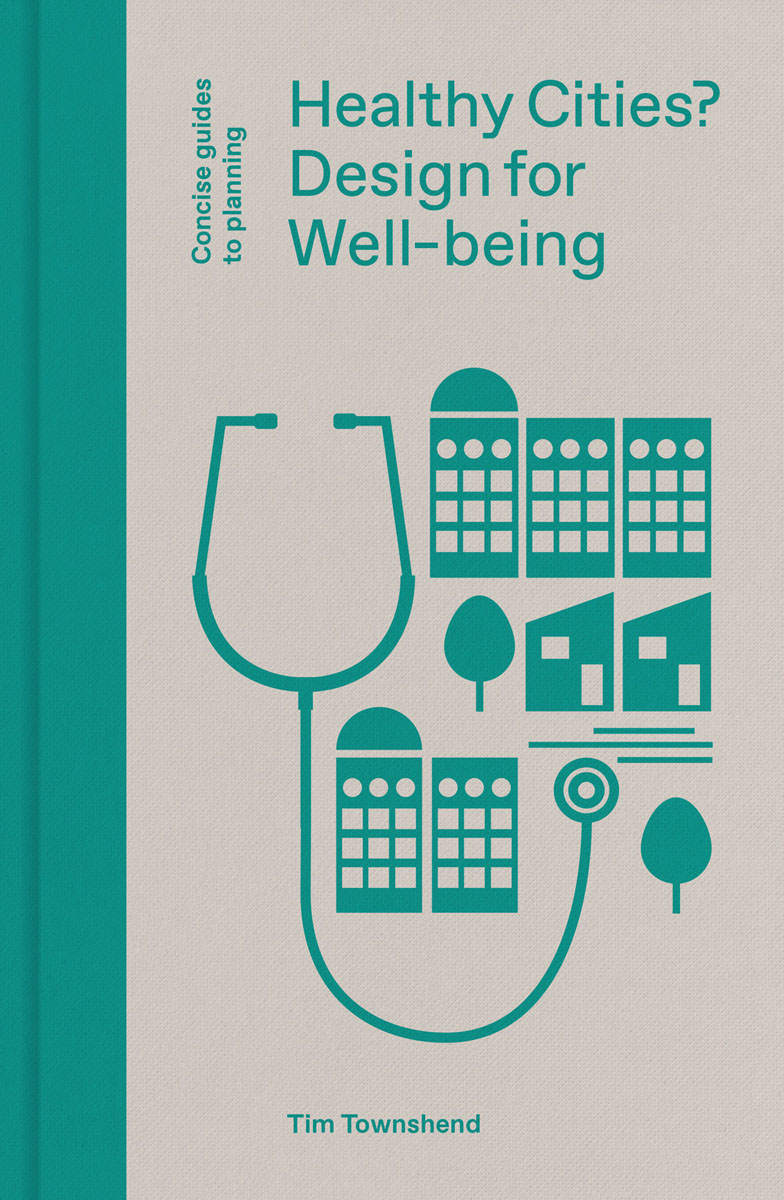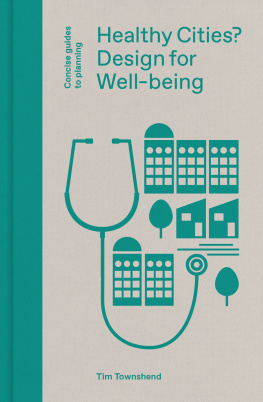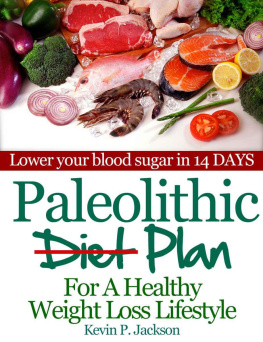

First published in 2022 by Lund Humphries
Lund Humphries
Office 3, Book House
261A City Road
London EC1V 1JX
UK
www.lundhumphries.com
Healthy Cities? Design for Well-being
Tim Townshend, 2022
All rights reserved
ISBN (hardback): 9781848223301
ISBN (eBook Mobi): 9781848223325
ISBN (eBook ePub): 9781848223318
ISBN (eBook PDF): 9781848223295
Concise Guides to Planning (Print): ISSN 25168177
Concise Guides to Planning (Online): ISSN 25168185
A Cataloguing-in-Publication record for this book is available from the British Library.
All rights reserved. No part of this publication may be reproduced, stored in a retrieval system or transmitted in any form or by any means, electrical, mechanical or otherwise, without first seeking the permission of the copyright owners and publishers. Every effort has been made to seek permission to reproduce the images in this book. Any omissions are entirely unintentional, and details should be addressed to the publishers.
Tim Townshend has asserted his right under the Copyright,
Designs and Patent Act, 1988, to be identified as the Author of this Work.
Cover design by Stefi Orazi
Copy edited by Pamela Bertram
Typeset by Jacqui Cornish
Proofread by Patrick Cole
Set in Favorit
Printed in the United Kingdom
All illustrations and photographs are the authors own with the exception of the following figures: U+I.
Contents
Chapter 1
Lessons from History: Special Places to Everyday Spaces
Chapter 2
Definitions and Measures
Chapter 3
Active Lives, Active Travel
Chapter 4
The Need for Healthy Homes and High Streets
Chapter 5
Green Infrastructure for Health and Well-being
Chapter 6
The Benefits and Burdens of the Past: Heritage, Place and Well-being
Chapter 7
Towards Health-Promoting Salutogenic Cities?
Foreword
I really enjoyed reading this incredibly powerful and insightful book. In many ways it carves out a unique and incredibly timely agenda for putting health and well-being back at the heart of planning and urban design. But it does much more than this it provides a detailed case for why healthcare providers and public health officials need to engage with planning and urban design issues if we are truly to make a paradigm shift towards community-level preventative approaches to healthcare.
What truly inspired me about this book was the rich detail involved across each chapter that provided new nuggets of information and fresh insights even into areas of planning that I thought I knew well, such as the context-setting introductory chapter. It helps, too, that the book is so well written, its arguments clearly set out and the case convincingly made for why each of the issues introduced in successive chapters deserves to be taken seriously by practitioners of planning and public health officials. Over the course of the book a clear intellectual agenda emerges for putting health and well-being at the centre of how we create better, healthier, more enjoyable cities for the future.
I cannot recommend this book to you highly enough. I hope you enjoy reading it and gain as much from it as I certainly did. It is also a wonderful companion to some of the other books in this Concise Guides to Planning series, including Planning, Sustainability and Nature (Dave Counsell and Rob Stoneman), Green Infrastructure Planning (Ian Mell), Planning, Transport and Accessibility (Carey Curtis), Conserving the Historic Environment (John Pendlebury and Jules Brown), The Urban Design Process (Philip Black and Taki Eddin Sonbli), Planning for an Ageing Society (Rose Gilroy) and Children and Planning (Claire Freeman and Andrea Cook).
Graham Haughton, Series Editor
Acknowledgements
I would like to thank the following people for agreeing to be interviewed in connection with this volume: Caroline Clapson Planning Consultant; Gillian Dick Spatial Planning Manager, Glasgow City Council; Martin Evans Creative Director, U+I Plc; Tom Gray Senior Ecologist, ARUP; Paul Karakusevic Founding Partner, Karakusevic Carson Architects; Jess Kennedy Associate Director, ARUP; Katherine Quigley Social Investment Manager, Nationwide Building Society; Rosie Rowe Programme Director, Healthy Bicester; Dhruv Sookoo Architect, MetWork; Zoe Webb Senior Environmental Consultant, ARUP. Apologies to anyone I have missed.
Special thanks to Liz Brooks for her invaluable assistance with proofreading and copy editing.
Chapter 1
Lessons from History: Special Places to Everyday Spaces
In this chapter, we trace 2,500 years of human history, from ancient Greece to the end of modernist-inspired planning in the late 20th century, and reflect on key themes that run through this period.

Early beginnings
The notion that certain places are infused with special properties that are good for health is a very ancient one and transcends cultures across the globe. From the 5th century BCE onwards, for example, the Greeks built an entire city dedicated to healing Epidaurus, in the eastern Peloponnese. It was built over many generations and at its height, Epidaurus could house several thousand visitors recovering from illness. People travelled from all over Greece to visit the city, though of course this would only have been an option for the relatively wealthy.
The natural landscape was very much integral to the original city, and Epidaurus was sometimes referred to as the sacred grove because the buildings were surrounded by trees (Alt, 2017). The city contained a variety of buildings, including temples where ritualistic purification and healing were performed. However, many structures were secular, designed for exercise and entertainment (). As embodied by the city, the healing process for the ancient Greeks included mental, spiritual and physical (bodily) needs.

Figure 1.1
The amphitheatre at Epidaurus, built for entertainment and mental stimulation, showing the relationship to the landscape beyond

Water and healing
Spas
A key part of the curative processes at Epidaurus involved washing and cleansing. Water, of course, is the most essential element of life and humans can only survive a few days without it. Over millennia, our relationship with water has also been multifaceted. Used as a source of food and for transportation, it has also been a source of spiritual inspiration. To the ancient Greeks and Romans, sources of water, such as springs and rivers, had their own distinctive deities. Even today, most major religions include water-based ceremonies as part of ritualistic purification.
Next page
















